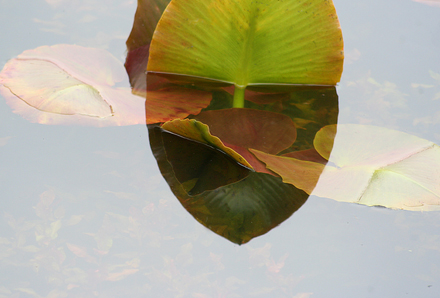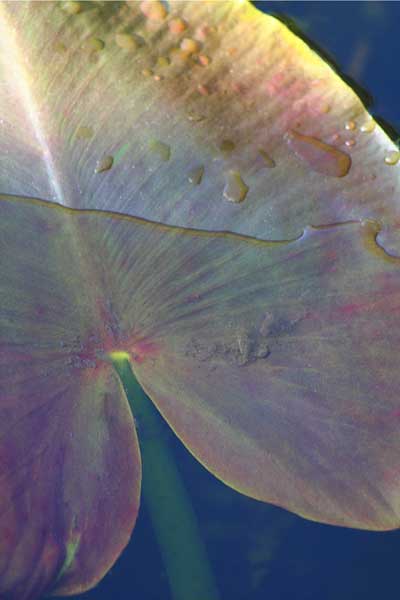Meditation’s
Other Face
We journey to heart
through love first,
thought second.
My transition from a structured spiritual practice to a spontaneous one occurred on a cold, soggy day in February of 1981. I recorded this life-changing event in the following paragraphs.
It is late afternoon and, despite a handful of vitamins and a day in bed, I’m coming down with bronchitis. Hoping that warm water will clear my head, I climb into the shower while recalling two spiritual teachers with whom I have been studying. Each believes that every human being is endowed with the same divine energy and healing ability as the great spiritual masters. Although I am new to the interior life, I muse, “I wonder if I can heal myself of bronchitis?”
From one teacher, I have learned to hear an inner voice that calls itself the “voice of my heart.” This voice speaks to me with a vocabulary and a message that fits neither my present life as a graduate student nor my childhood lived with academic parents. When I ask my heart’s voice how to study for Qualifying Exams, it answers, “You are love, see the world through the eyes of your heart.” When I ask how to bring more friends and money into my life, it advises, “All will flow to you when you are with me.”
In between shampooing and conditioning my hair, I put my teacher’s philosophy—and my heart’s voice—to the test. Closing my eyes and quieting my mind, I ask my inner voice how to cure myself. I receive the most unusual message yet: “Cast all evil from your body in the name of Jesus the Christ.” I am dumbfounded, having been raised in a Science of Mind Church that taught the power of positive thinking but spoke little of Jesus and never of evil. However, I trust my inner voice. So, with steam rising around me, I look within for my own divine spark. As I give myself wholeheartedly to the search, I feel my energy align along a vertical axis up and down the middle of my body while simultaneously expanding outward into great open space. Although this is a new experience, I am too immersed in it to be surprised. I say aloud, “I cast all evil from this body in the name of Jesus the Christ.” Immediately, a bubbling current of energy rises in my body, while my arms, loose at my sides, shake dramatically for several seconds, then stop. Now I am surprised! Knowing that I have touched a spiritual power, I repeat the phrase. My arms shake again.
Suddenly the shower water turns cold. Realizing that I have exhausted our tiny heater, I bring my spiritual experience to an abrupt halt. My bronchitis is no better, but my experiment in self-healing will have to wait.
Later that evening, I lie down on the living room couch and continue my experiment. While opening myself to the divine source within me, I think, “I cast all evil from this body in the name of Jesus the Christ.” With the force of a powerful river, an energetic current erupts somewhere in my lower torso, then rises upward. Somehow I recognize this river. In it flow love, joy and peace. I welcome this river like a long-lost friend and allow it to carry me home.
When this love-stream first flooded my body, I had no name for what was happening to me. Although I knew that quieting my mind was essential to the process (thoughts distracted me from heart’s energetic flow), it didn’t occur to me that my experience might be a “meditation.”
At that time, I mistakenly assumed that meditators always hold the same pose throughout meditation. But from that February evening on, when I opened to the inner river, it often caused my body to tremble and shake, like a Quaker. With the coming of spring, the shaking stopped but then the spiritual flow began prompting my body to bend, twist, undulate and sway in expressive and symbolic forms.
In the beginning, I also erroneously believed that meditators only focused on fixed objects prescribed by tradition. These objects might be seen (in the mind’s eye or externally) or repeated (out loud or silently), but the meditation object itself originated, I thought, in the external environment and did not spontaneously change during spiritual practice. During my experiences of spiritual energy, however, I focused on the flow active inside me and on its ever-changing and unpredictable promptings.
Within a few months, my curiosity sent me to book stores where I discovered that other spiritual seekers experience a sacred current active inside them. Christians, I learned, call it the “Holy Spirit”; Hindus, the “kundalini.” The Chinese speak of “chi”; the Japanese of “ki.” In time, I came upon other names for a sacred inner current. The Xhosa people of South Africa, for example, call it “umbelini.” To the Polynesians it is “mana” and to the Kalahari Bushmen, “num.”
Finally in 1990, I came upon a book by psychiatrist Claudio Naranjo called, How to Be: Meditation in Spirit and Practice. In that essay, Naranjo distinguishes between structured meditations in which practitioners inhibit spontaneous experiences in order to focus upon fixed and externally given forms and formless meditations in which seekers dwell upon the spontaneously arising sensations and expressive actions of their own deeper natures.* **
Structured meditations (which I also call “techniques” or “exercises” in this essay) are effortful, willed activities patterned by the mind. During these activities, seekers must think to some degree in order to assume the correct body pose, envision the proper religious symbol or imitate the prescribed breathing pattern. These kinds of practices help seekers move toward the divine.
In formless meditations, seekers quiet their thoughts in order to receive from a divine power. In time, a current of awareness, a luminous essence or a sacred force embraces the seeker.
After reading Naranjo’s description of formless meditations, I concluded that my un-programmed experience could be considered a “meditation” after all.
Formless Meditation:
A Spiritual Family
For the next two decades, I continued my research, finding other seekers in the world’s religions who take an interior reservoir or flow of divine energy as their meditation object.
Some of them move and vocalize during meditation; others do not. Some, like me, are ordinary seekers; others are internationally known spiritual leaders. Some call their experiences “meditations;” others use terms like “contemplation,” “worship” or “exercise.” What we all share is a spiritual practice that directs attention away from mind-based forms to a spiritual current or essence located within the body.
Through reading books—and while attending spiritual retreats and workshops—I discovered several religious traditions in which practitioners’ minds abide in silent awareness while their bodies remain quiet.
The contemplative Taoists of ancient China, for example, stilled their minds in order first to perceive, then to reside, in the current of the Tao—the mysterious power that sustains all things.
Al Hallaj, a tenth-century Muslim from Bagdad, portrayed the Sufi spiritual journey in stages. During the beginning phase (“The Path of Effort”), seekers engaged in effortful activities. When they reached stage two (“The Effortless Path”), they left behind willful activities and resided in the Beloved’s pure and silent grace.
In fourteenth-century England, the anonymous author of the Christian manuscript, The Cloud of Unknowing, advised advanced monastics to place their mental spiritual activities under a “cloud of forgetting” so that they could rest in silent, loving awareness of God.
Later, other participants in the Catholic tradition of Infused Contemplation (like the medieval mystic, St. Theresa of Avila, and the contemporary, Fr. Thomas Keating) left behind discursive thought (thought that moves from point to point) during spiritual practice in order to commune, in silence, with the Indwelling God.
In India, the twentieth-century Hindu sage, Ramana Maharshi, created a Direct Path to Self-Realization. This path invited seekers who were “ripe” to focus silently upon Heart—their own divine nature—so that It could draw them home to Itself.
Experienced students of Tibetan Buddhism’s dozgchen—a formless meditation dating from the eighth century that exists today—set aside mind-based exercises. During spiritual practice, they abide in the state of rigpa–primordial open awareness, our Buddha nature.
Llewellyn Vaughan-Lee, a contemporary teacher in the Naqshbandi Sufi path, calls Western wayfarers beyond the early, effortful phases of spiritual practice into a time of silent receptivity. During these advanced stages, they learn to rest and remain in primal awareness of God.
During my research, I also discovered men and women whose silent encounters with the divine flow lead them into physical movements and/or vocal sounds.
In sixth-century China, for example, Buddhist master Chih-I practiced T’ien T’ai meditation and entered the state of dhyana (deep silence). Immersed in this state, he eventually experienced what he called, “involuntary movements.” Fourteen centuries later in China, Yin Shih Tsu studied Taoist and Buddhist meditative practices. These processes released prana (the vital principle) in his body, resulting in automatic movements (quaking, waving of hands, dancing of feet) and his own physical healing.
In America, the eighteenth-century Protestant Ann Lee and her followers—the Shakers of New England—opened to the divine silence during worship meetings. In this receptive state, they allowed the power of God to shake and dance them during communal services. A century later in the Northwest, Native American Joe Slocum and members of the Indian Shaker Church, advocated not only wordless experience of God but also the physical shaking that resulted from that encounter.
In twentieth-century Indonesia—and later in the West—Pak Subuh, and his interfaith followers in the Subud brotherhood submitted, in silence, to God’s will and allowed the inner spirit to lead them into unexpected movements and vocal expressions.
In India, the twentieth-century Hindu saint, Anandamayi Ma, lived in obedience to God. Throughout her life, a silent inner Power guided her into the postures and movements of innumerable spiritual paths. During that same century the Indian Swami, Kripalvananda, experienced a mysterious spiritual awakening. Later, his sahaj (natural) yoga students in the East and the West, opened not only to the current of prana-kundalini in their bodies but also to its dance-like movements.
Another twentieth-century Hindu Swami, Muktananda, also experienced a powerful kundalini awakening. After he became a guru, he advised his Siddha Yoga students to meditate on the Self. When the kundalini awoke, they welcomed its transforming movements and vocal sounds.
In Japan, Ikuko Osumi, a twentieth-century master in the Japanese tradition of Seiki Jutsu, learned to enter a Zen-like silence. This stillness allowed seiki—the life force—to flow within her body, prompting her into movements and sounds that both healed and cured.
When I first began this research, I knew only of the New England Shakers, but with the passage of time, my list of kindred spirits grew. Eventually, I realized that—even though many of these seekers would never know (or know of) one another—I belonged to a very large spiritual family indeed.
We were Muslims, Hindus, Taoists, Christians and Buddhists. We wore the woolen cloaks of Persia, the un-dyed silks of ancient China, the dark monastic robes of medieval England, the white saris of rural India and the polyester jackets of modern, urban America. But each of us had given ourselves to the silent, formless side of spiritual practice—to meditation’s “other face.”
A Reciprocal Relationship
During the course of my research, I also discovered that structured and formless meditators occasionally criticize one another. When they do, they often portray their own approach to meditation as “mature” while designating the opposite approach as “immature.”
For meditators attracted to structure, spontaneous spiritual experiences can seem undisciplined; “going with the flow” sounds sloppy, haphazard and directionless. When a spontaneous practice includes un-programmed movements and sounds, the experience may look chaotic and out of control—even dangerous.
To formless meditators, structured practices sometimes seem superficial because they keep seekers mired in thought. When structured meditators become obsessed with perfecting techniques, it is easy to conclude that they have lost their way: focused only on the means (spiritual exercises), they appear to have forgotten the goal (direct experience of the indwelling God).
If we step back from personal preferences and view these contrasting approaches to meditation from the perspective of the history of religions, we see that formless and structured practices are reciprocally related.
When performed wholeheartedly, mental exercises eventually lead seekers into spontaneous experiences. Like well-drilling equipment, spiritual techniques pound through the hard shell of the ego (the conditioned personality) until the living waters of the spirit rise up. Then, a new spiritual task emerges: seekers must now learn to cooperate with the unpredictable outpourings of the holy flow.
When seekers open themselves repeatedly to the spontaneous movements of formless meditations, they may eventually find themselves performing the gestures, breathing patterns or vocalizations of mind-based practitioners. During my own periods of “silent resting,” for example, heart’s sacred stream has often prompted me to spin like a Whirling Dervish, stretch like a Hindu yogi and glide like a Tai Chi practitioner—but these movements were guided by heart, not by my mind.
Based on my own experiences—and on the writings of several yoga teachers—I suspect that many spiritual practices began during silent, spontaneous experiences of spiritual energy. Only later were they codified and taught as mind-based techniques.
Paradoxically, if we go far enough into traditional spiritual exercises, we find ourselves immersed in spontaneous experiences. Diving deep into silent spontaneity, we discover, to our surprise, that we embody a host of traditional forms.
In November of 1993, an interfaith group in the Northwest invited me to give a demonstration of my unusual meditation practice, including my heart-led movements and sounds. To explain my interior process with a minimum of words, I wrote a free-verse poem, summarizing my experience of spontaneous meditation.
Embodying the Light
Quieting my mind, I wrap myself in silence,
 as if it were a garment.
as if it were a garment.
Abiding in the stillness,
I offer myself to love.
I watch the coming and going
of my mind’s likes and dislikes.
By ignoring them,
I make a space inside me.
I become a valley and
a great power flows into me.
Sometimes this power
is like a rushing river.
Today it is a gentle light,
streaming in my body.
I sense that the light
wants to move me,
so I let it.
Under its guidance,
I shake like a Quaker,
sit like a yogi,
twirl like a Dervish,
caw like a raven,
scream like a mad woman,
groan like a dying man and
coo like a contented child.
I enter a realm where
 everything is connected,
everything is connected,
finding, to my surprise,
that countless creatures
dwell within me.
Endless and nameless
are the forms I encounter.
I welcome each one,
no matter how ugly.
I release each one,
no matter how beautiful.
Meeting these myriad
forms with an open heart,
I help them return,
like lost children,
to the Great Mother.
Letting the unmovable
initiate my movements,
allowing the inaudible
to prompt my sounds,
I learn what it means to embody the light.
Notes
* Not all meditative types fit into these two categories. See Naranjo’s book for a fuller discussion.
**For ease of identification, I often refer to spontaneous meditation as a “formless” or “unstructured” discipline. In fact, spontaneous meditations do frequently have form, but it is the true self that gives them their shape. This kind of spiritual practice appears formless to the ego-mind because thought does not provide the structure.



